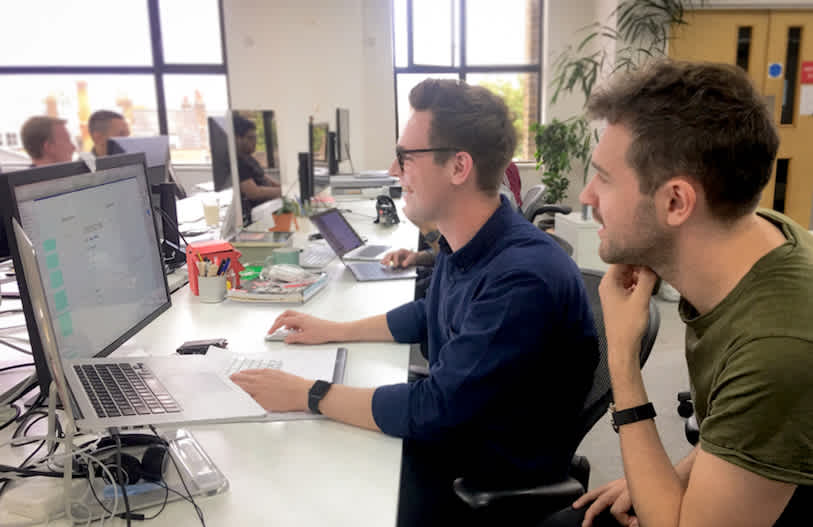How Marketing and Design teams can feel the love…❤️

Last editedJan 20203 min read
Marketing and Design are remarkably similar teams. They’re often seen as the business’s creative arms; fuelled by customer insight, constantly testing and improving their work using data.
A strong bond between these teams is essential to any growing business. Successful lines of communication as well as shared goals and learnings from their projects will enable each team to do their most impactful work.
As a Product Marketer, I work on communication pieces to support new product work, such as in-product copy, web pages, guides, sales decks, and videos. Most of the content I build requires a good amount of design input before it can be used as external facing material. Meaning I rely pretty heavily on design teams to help me do my job well.
At a high-growth company like GoCardless, we have new faces appearing all the time, including in the design and marketing teams. It’s important for teams to establish core ways of working together that won’t get diluted when new people join, or disappear completely when people move on.
To understand how Marketing and Design can work best together, I asked the teams here at GoCardless to think about what's helped or hindered them in the past. I've compiled their advice into the following six tips:
Tip #1: Make sure you’re solving the same problem.
Before anyone pens a brief, make sure you agree on what problem you’re solving. We need to make sure we’ve got the same answers to questions like:
What are the customer problems we're trying to solve?
How will we measure the outcome?
What do we know about the customer already?
The answers should come from both teams. It’s often Marketing that create briefs for design teams, but really you should build briefs together and agree on key details from the start.
Doing this helps the process of giving and receiving feedback on design work. If your feedback is framed around a problem that you’ve both agreed on, it helps the marketing team steer away from more subjective, and frankly useless, feedback like “Can you just make the colours a bit brighter?”
Tip #2: Work together as early as you can.
Once work begins, make sure you’re communicating regularly. Don’t begin a brief and then only speak again at the end of the project. Things change - and it’s amazing how often changes aren’t communicated properly.
If something doesn’t make sense, we need to ask questions. Don’t assume somebody understands what you mean either in the brief or any subsequent meeting. Always repeat things back to each other to confirm you’re both on the same page.
Tip #3: Avoid asking for finishing touches
To do our best work, we need to be invested in our projects from the very start. We’re not just there to provide words and pictures for each other at the end. All this does is delay the projects we’re working on, and cause friction between teams.
I’ve worked on projects where I’ve been asked to provide copy on something after the design work has already been finished. I’m also massively guilty of asking designers to make projects ‘look pretty’, when they should definitely have been involved from the start.
We should never just see each other as a resource to help us tidy up our own work. When we approach projects in this way, teams tend to discover additional requirements that weren’t considered at the start. This either forces one team to rush, increasing the likelihood of a mediocre output, or stretches a project way past its original deadline.
Tip #4: If something takes longer than 5 minutes to type, meet in person
This one’s not exclusive to Design and Marketing. Running projects over email or Slack is needlessly time consuming. And written descriptions of your thoughts and opinions are always going to be open to interpretation.
By talking to one another, projects instantly become more collaborative and more likely to finish on time and within scope.
Tip #5: Share your results with each other
We often put great effort into launching a project, but then forget about the learnings that can help us improve next time.
As designers, make sure you’re getting the results from your marketing team about the campaigns they’re running. Learn about the small details, like what imagery or colours perform better than others.
For marketers, when your design team runs user research projects, always ask one of them to take you through their findings. Better yet, watch your design team run a user research session in person. Proper user research led by a design team is better than any kind of focus group that a marketing team might run.
Designers can be the clearest window into the minds of our customers, helping marketing teams really understand the needs and motivations of someone using our products. Sharing these learnings enables the development of more customer-centric messaging and better targeted campaigns.
Tip #6: Let go of ownership
Neither team reports to the other, so why not relinquish some control? Really, the end customer owns all our projects; our super design and marketing skills are ultimately used for their benefit.
Doing what the data tells us and not basing decisions on assumptions will always bring our teams together. On any given project, ensure that achieving the best possible customer journey comes first.

